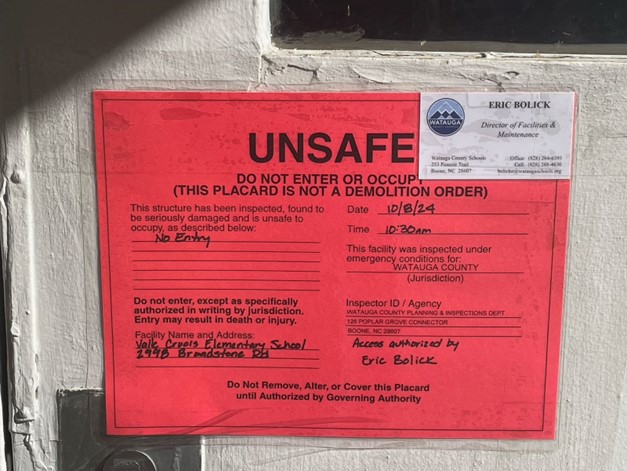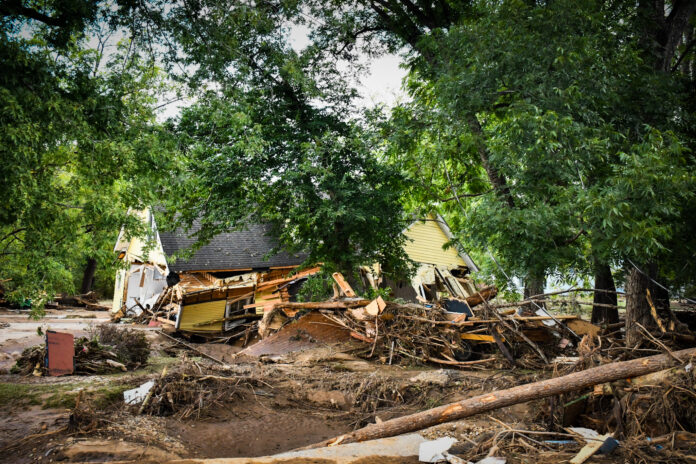Gov. Josh Stein announced on Monday his administration’s proposed budget for continued Hurricane Helene relief in western North Carolina.
During a press conference at the MANNA Food Bank in Mills River, which was relocated from Asheville after the hurricane, Stein appealed to the General Assembly to appropriate funds as soon as possible.
“If we do not act, some businesses will not be here in the summer, and we will miss an entire building season before the winter weather comes again in 2025,” he said.
EdNC’s coverage of state funding for WNC
The proposed budget is intended to supplement existing state and federal funding for immediate needs, he said.
The proposal totals $1.07 billion in funding split into five categories:
- Revitalizing the state economy
- Supporting farmers
- Rebuilding safe and stable housing
- Restoring infrastructure
- Supporting children and families
Some line items included are VisitNC tourism promotion; private road and bridge repairs and replacement; immediate minor home repairs and non-FEMA-eligible needs; small and volunteer fire department grants; wildfire risk reduction; and food bank grants.
Read the full proposal below:
Summer learning and tuition assistance
To support students who missed extensive periods of learning due to school closures and other hurricane-related factors, Stein’s proposal includes $34.2 million for K-12 summer learning programs.
“Hurricane Helene stopped schools — in some places, for weeks. Students missed critical instructional time,” Stein said.
Western North Carolina has also seen heavy snow this winter, which suspended schools again. For example, schools in Watauga County missed 18 days of school after Helene and 13 due to winter weather so far.

The funding would cover the cost of 30 days of summer instruction to students at over 100 public schools in Helene-affected counties.
The N.C. Department of Public Instruction (DPI) estimated that 60% of K-8 and 20% of high school students would participate in a summer instruction program, according to the full proposal document. Students who missed more than 15 days of school in affected districts would qualify.
Also included in the proposed budget is $2 million to the UNC Board of Governors to assist hurricane-impacted university students at Appalachian State University, Western Carolina University, and UNC Asheville with paying tuition, fees, and emergency expenses that affect students’ ability to remain enrolled. The Disaster Recovery Act of 2024 allocated $5 million for the same purpose, but that money has since been completely expended, according to Stein’s proposal document.
What is GROW NC?
On Stein’s first full day in office, he signed five executive orders on Hurricane Helene relief, including orders temporarily waiving regulations to increase the supply of temporary housing and the procurement of vendors to repair roads and bridges.
Soon after, Stein hired a team to head a newly created office: the Governor’s Recovery Office for Western North Carolina (GROW NC).
On Jan. 30, representatives from GROW NC reported to the House Select Committee on Helene Recovery on the status of recovery efforts and what’s coming next.
“GROW NC is essentially intended to be a nerve center for the recovery,” said Matt Calabria, director of GROW NC. He emphasized that the office is a small team hoping to avoid bureaucracy and act nimbly, and that “a number of the GROW NC staff are or will be based out of western North Carolina.”

Calabria was joined at the meeting by Jonathan Krebs, Stein’s western North Carolina recovery adviser.
The throughline of Calabria and Krebs’ presentation to the committee was: Helene recovery is significantly hampered by a lack of federal funding.
“We did not receive near enough money to support the needs in western North Carolina,” said Krebs.
Later, Krebs added:
“We didn’t get enough money, and it’s very likely that there will be a middle income group of people that are not going to be served because we run out of funds… Right now, the prioritization will focus on the poorest of the poor in North Carolina.”
Currently, only an estimated $15.7 billion of federal funds are coming to North Carolina, while $25.7 billion was requested, according to Calabria and Krebs’ presentation. The North Carolina Office of State Budget and Management estimated in December 2024 an all-encompassing figure of $59.6 billion in damages and needs after Hurricane Helene.
Uncertainty was thrust into recovery operations when the Trump administration announced a pause on federal funding. According to Krebs, FEMA funds had been restored after a brief stoppage, but HUD funds were still unavailable last Thursday.
Krebs, like Stein, noted delays in funds for permanent housing recovery could put projects at risk because of seasonal construction concerns.
“When you go to pour concrete in the fall and it drops below 20 degrees consistently, it does not set particularly well,” he said.
At the press conference, Stein emphasized the urgency with which the state needs to act.
“The folks out here have rallied to help each other, neighbor helping neighbor, and it has been truly inspiring for all of us to watch. But the extent of the damage, nearly $60 billion, is much more than the people of western North Carolina can bear,” he said. “There are some things the federal government won’t pay for and that the people of western North Carolina need now.”





